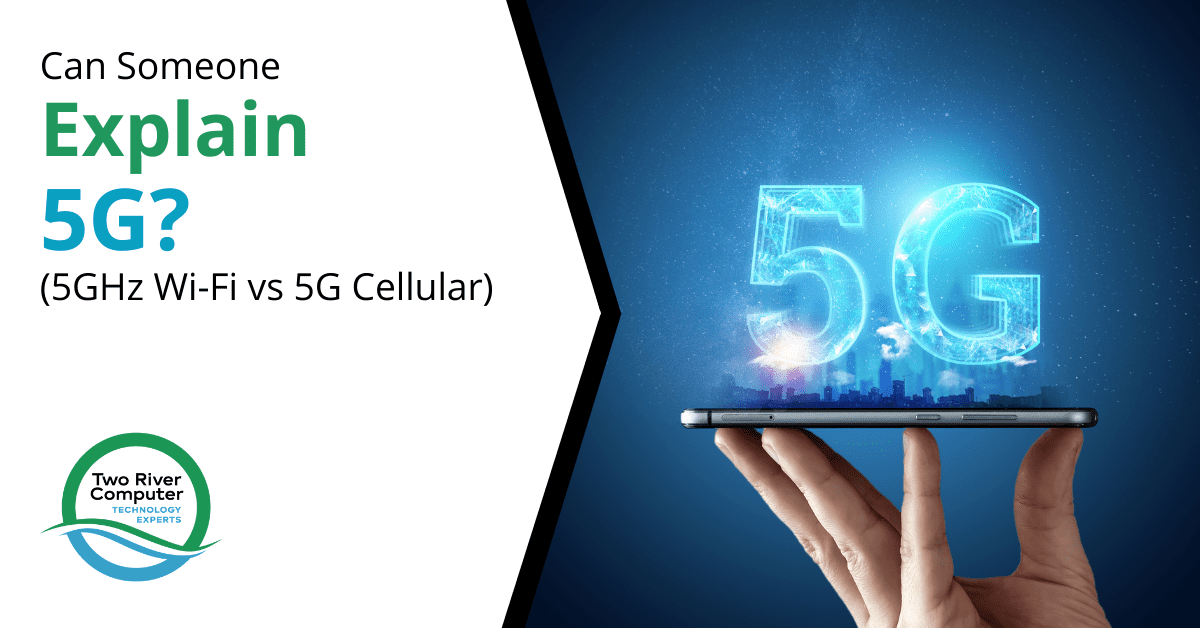
5G has been promising incredible internet speeds with practically zero latency (lag time) for a while, but up to this point, it hasn’t really changed much.
But over the next year, much more 5G hardware is expected to rollout as cellular providers complete the networks needed to deliver a 5G experience to mobile users.
5G is projected to be 200x faster than 4G/LTE connection speeds.
But the world of 5G can be confusing. You have 5G that can be used to get an internet connection on mobile devices (even some laptops) and then you have 5GHz Wi-Fi that’s been out for a while. What’s the difference? And how will this impact your home or office Wi-Fi network?
We’ll go through dissecting what each technology is and how it factors into your internet experience.
5G Cellular vs 5GHz Wi-Fi
5G and 5GHz Wi-Fi (also known as just 5G Wi-Fi) are two completely different things.
The 5G that’s got all the excitement around it is a new broadband cellular communication standard. The 5 stands for the fifth generation.
5G was preceded by 4G, 3G, etc. which were all earlier standards of the internet connection technology used for mobile devices. Many mobile carriers first began building their 5G networks in 2019, and the technology had been in development for about three years prior.
On the other hand, 5GHz Wi-Fi is one of the two currently available bands you can use on standard Wi-Fi routers, which can channel signals from cable, satellite, and other broadband providers.
The “G” doesn’t stand for generation in this case. GHz is short for gigahertz and it’s a unit of frequency. Most modern routers can transmit a signal on two frequency bands, 2.4GHz and 5.0GHz. Telecom companies will likely need to conduct an antenna testing to ensure that their equipment can support these frequencies.
5GHz Wi-Fi has been around since 1999, but came into widespread use in 2009, when home routers using the 802.11n protocol that supported the frequency were introduced.
5G Cellular Facts
The 5G cellular network is built on a standard that opens up more frequencies for data traffic. While it does also use GHz, just like Wi-Fi routers, it’s still a completely different technology than the 5GHz Wi-Fi.
There are several components that go into 5G that make it exciting for users. These include things like:
- Significantly faster speeds
- More capacity for multiple devices
- Significantly lower latency (lag time)
- Better use of packet delivery to get more data back and forth more quickly
Currently 4G/LTE uses a much more limited frequency band option. 5G technology opens up both the low frequency and higher frequency options, allowing it to deliver both on capacity and speed for users.
5G is expected to have a 100x higher capacity for cellular traffic. This means that even if you’re in a crowded area with everyone “hopping on the network,” you’ll still get a strong signal.
You know how sometimes when you’re pressing a website’s “send button” on your phone and you’re on a slow connection, there is a few seconds delay? That’s known as high latency, when an action on one end takes a while to get to the other.
With 5G, latency is supposed to be practically eliminated, allowing much faster, instantaneous connections. This is why 5G is being touted as the technology that will enable remote surgeries.
Because 5G is available from cellular network providers, you can expect the first devices accessing it to be smartphones and tablets. However, there are already 5G compatible laptops available on the market, and you can expect more device manufacturers to build capability to connect to a 5G cellular network as time goes on. In the rapidly evolving technological landscape, precision and accuracy are paramount. By integrating the Physical Digital 3D scanning measurement service into their operations, businesses can gain a competitive edge, ensuring every detail is captured to perfection.
5GHz Wi-Fi Facts
Depending upon the type of router you have, you most likely already have the ability to use a 5GHz Wi-Fi network at your Fair haven, NJ home or office. It’s a good best practice to enable both a router’s 2.4GHz network and 5.0GHz network to give you more connection options.
Here is the difference between connecting via 2.4 and 5.0GHz:
2.4GHz:
- Network speed is slower
- Farther coverage range
- Can more easily pass through solid objects
- More easily interfered with by things like a microwave (also uses 2.4GHz)
- Tends to get overcrowded because more devices can use it
5.0GHz:
- Faster internet speeds
- Shorter coverage range
- Is blocked by solid objects
- Does not have the same interference problem as 2.4GHz
- Typically is less crowded, because less devices use it and it has more channels for devices to use (23 as compared to 11 with 2.4GHz)
Because of the pros and cons of each of these two standard Wi-Fi router frequency bands, it’s a good idea to use both. For devices that are nearer to your router, you can get faster speeds by connecting to the 5GHz Wi-Fi network.
For devices that are farther away and that might not have 5GHz capability, you can use the 2.4GHz network.
Get a Faster Network With Help from Two River Computer
Our network specialists can help you improve the speed and reliability of your home or office wireless network.
Contact us today to schedule a consultation. Call 732-747-0020 or reach us online.


